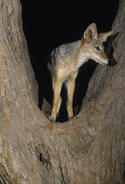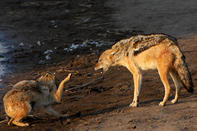Scat Defences

Being smaller carnivores, jackals will characteristically use elevated sites such as rocks or compacted vegetation to deposit their scat.
This serves as a territorial marker but is also believed to convince intruders that the territory holder is larger than it really is as the dung is higher up.
Sometimes jackals will deposit their scat, seemingly defiantly, on top of larger carnivores’ scat.
Jackals may rest out of sight during the hotter parts of the day using dense vegetation, holes or rock crevices to secret themselves away.
Sometimes on cold nights, they will sleep on top of flattened piles of elephant dung or on the vast patches of impala middens. The dung has insulating properties that help to conserve warmth.
Competition

Inter-species (between species) competition occurs between jackals and caracals, which keeps both carnivores’ populations in check. It would appear that in an area of high jackal concentration, lower populations of caracal exist and vice versa. Jackal may overuse the prey in a given area and the caracal may then move out in search of new resources.
Because jackal and caracal mutually prey on each other’s pups and kittens, at high densities of one or the other, the likelihood of coming across the opponent’s young increases and further puts pressure on that species to leave the area.
By Megan Emmett